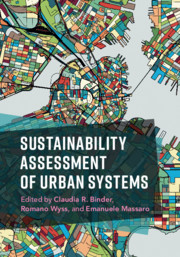Book contents
- Sustainability Assessment of Urban Systems
- Sustainability Assessment of Urban Systems
- Copyright page
- Contents
- Preface
- Acknowledgments
- Contributors
- General Introduction
- Part I Theoretical Background
- Part II Integrative Approaches for Sustainability Assessment
- Part III Perspectives on Urban Sustainability
- 10 Conceptualizing Urban Systems for Sustainability Assessment: Four Powerful Metaphors
- 11 Sustainability Issues in Urban Systems from a Metabolic Perspective
- 12 Urban-Industrial Supply Systems
- 13 Indicators for Assessing the Sustainability of Cities
- 14 Ontology-Based Integration of Urban Sustainability Indicators
- Part IV Focal Points of Urban Sustainability
- Index
- References
12 - Urban-Industrial Supply Systems
From Global Challenges to Strong Urban Sustainability
from Part III - Perspectives on Urban Sustainability
Published online by Cambridge University Press: 27 March 2020
- Sustainability Assessment of Urban Systems
- Sustainability Assessment of Urban Systems
- Copyright page
- Contents
- Preface
- Acknowledgments
- Contributors
- General Introduction
- Part I Theoretical Background
- Part II Integrative Approaches for Sustainability Assessment
- Part III Perspectives on Urban Sustainability
- 10 Conceptualizing Urban Systems for Sustainability Assessment: Four Powerful Metaphors
- 11 Sustainability Issues in Urban Systems from a Metabolic Perspective
- 12 Urban-Industrial Supply Systems
- 13 Indicators for Assessing the Sustainability of Cities
- 14 Ontology-Based Integration of Urban Sustainability Indicators
- Part IV Focal Points of Urban Sustainability
- Index
- References
Summary
Global un-sustainability is shaped by a form of urbanisation that has created urban systems with disproportionate natural-resource consumption. This results in severe damage to the global ecosphere. The causal mechanisms of this relationship can be related to Castell’s ‘dominance of the space of flows’ or expressed in terms of World City Networks. Critical to sustainable transformation are material-resource and energy-network flows, understood as teleconnections between urban sinks and planetary sources. So far, there is no interpretation of this nested global urban-industrial network and its correlated impacts that builds links to a sustainability transformation strategy. Concepts such as global commodity chains (GCC) offer valuable impetus, as they address research on material and product flows in globalised urban-industrial finance, information, and service networks. However, to achieve levels of sustainability transformation, a perspective that goes beyond an analytical and descriptive lens is necessary with regard to the design of sustainable supply chains. Moreover, qualitative extensions of Sustainable Supply-Chain Management (SSCM) in the understanding of ecological economics provide possibilities for solutions. In order to pave the way for this further, this chapter provides an outline of a multi-domain framework for sustainable urban-industrial supply systems based on strong sustainability and nested systems organisation theory.
Keywords
- Type
- Chapter
- Information
- Sustainability Assessment of Urban Systems , pp. 290 - 310Publisher: Cambridge University PressPrint publication year: 2020



